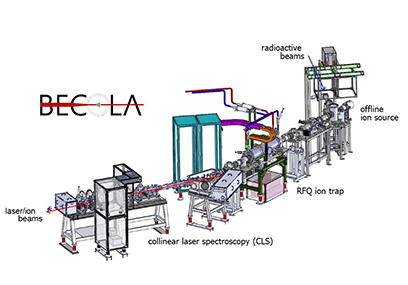How good is the N=28 magic gap in calcium and nickel isotopes? New data on charge radii adds a piece to the puzzle

Share this article:
Share this article:
A multi-institutional team of scientific users has published an article about the precision measurement of charge radii of neutron deficient isotopes below nickel-56 in the 23 September 2022 issue of the journal Physical Review Letters.
Nuclei with a “magic” number of protons or neutrons are more stable than other nuclei. Currently, the most widely recognized magic numbers are 2, 8, 20, 28, 50, 82, and 126. In nickel-56, a doubly magic nucleus, both neutron (N) and proton (Z) numbers are 28. The new data established the kink at N=28, which can be now compared to the N=28 kink in the calcium chain at the doubly magic calcium-48 with Z=20. Calcium and nickel behave very similarly at the magic number N=28.
A sudden change in slope—a kink—of the nuclear charge radius along a chain of isotopes is known to occur at magic neutron numbers. The origin of this kink and its relation to magicity of nuclear shells is still under debate. One of the open questions is whether the behavior of charge radii before and after the kink tells us anything about the strength of the shell closure.
“While the previous data on nickel-56 and calcium-48 indicate that nickel-56 is less magic than calcium-48, our new result shows that the kinks in charge radii are almost identical for the two isotopic chains,” said Felix Sommer, a graduate student at the Technical University of Darmstadt in Germany and lead author of the publication
Results are compared to state-of-the-art nuclear theories, and both nuclear density functional theory and ab initio theory using the advanced nuclear interactions reproduce this feature reasonably well. This suggests that the magnitude of the kink does not represent the strength of the shell-closure.
One region the scientists are excited about is that around the doubly-magic nucleus nickel-78 with N=50 (22 neutrons away from nickel-56), where extremely limited information is available at present.
Scientists performed the experiments at Michigan State University. They produced radioactive nickel isotopes through nuclear reactions, converted them into slow speed nickel beams, and transported them to the BEam COoling and Laser (BECOLA) spectroscopy facility. At BECOLA, they measured laser resonant fluorescence from the nickel beam as a function of the laser color. That allowed them to deduce the information about charge radius. FRIB, with its unprecedented reach of radioactive isotopes, will enable significant extensions of charge radii measurements.

